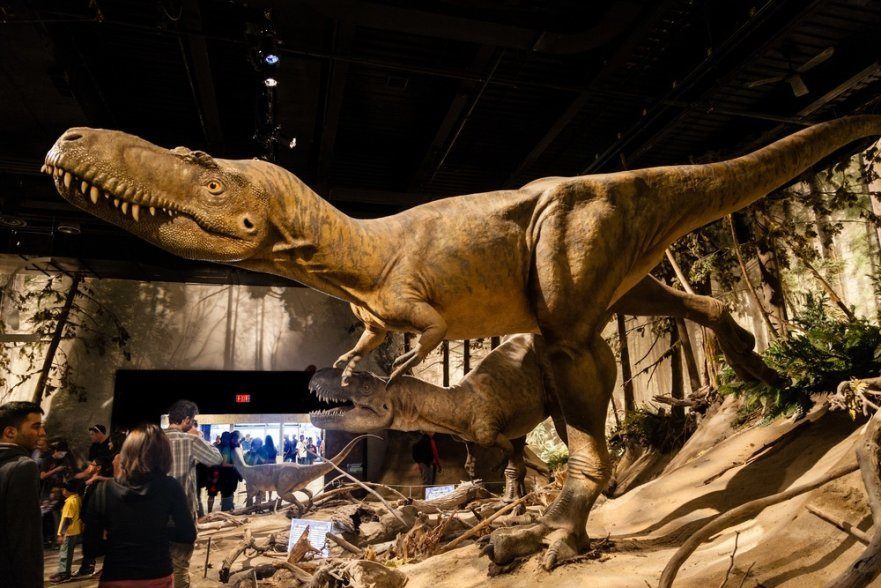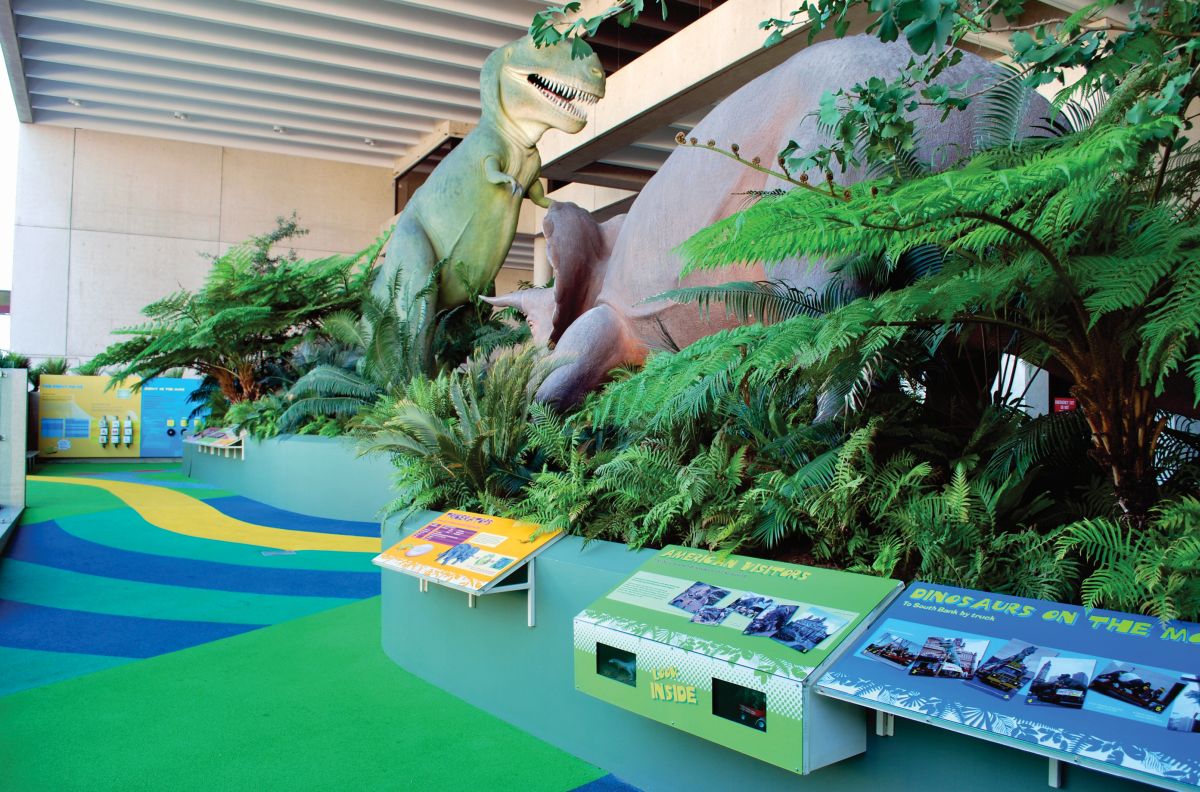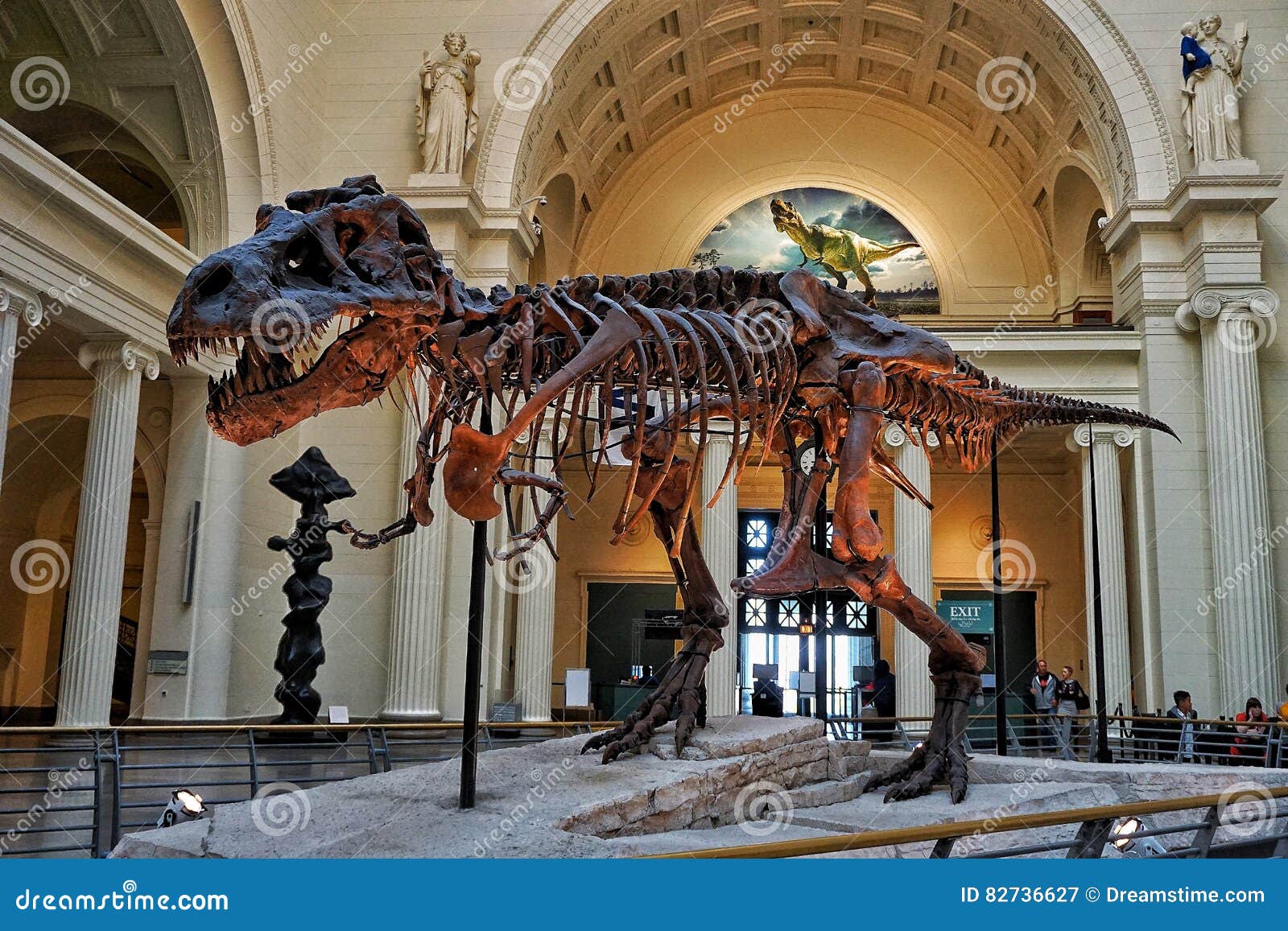The museum maintains a temporary exhibition program of traveling shows as well as in-house produced topical exhibitions. The professional staff maintains collections of over 24 million specimens and objects that provide the basis for the museum's scientific-research programs. These collections include the full range of existing biodiversity, gems, meteorites, fossils, and rich anthropological collections and cultural artifacts from around the globe. The academic faculty and scientific staff engage in field expeditions, in biodiversity and cultural research on every continent, in local and foreign student training, and in stewardship of the rich specimen and artifact collections.
They work in close collaboration with public programming exhibitions and education initiatives. Guests come from all around the world to see towering dinos, marvel at ancient artifacts from a royal Egyptian tomb or relax in a Chinese rock garden hidden inside the Cyrus Tang Hall of China. While a gigantic titanosaur skeleton named Máximo now guards the lobby, you'll find the Field's former greeter, SUE the T. There's something for everyone, and you can easily spend an entire day here.
Already at its founding, the Field Museum had a large anthropological collection.A large number of the early natural history specimens were purchased from Ward's Natural History Establishment in Rochester, New York. An extensive acquisition program, including large expeditions conducted by the museum's curatorial staff resulted in substantial collection growth. During the first 50 years of the museum's existence, over 440 Field Museum expeditions acquired specimens from all parts of the world. There's plenty of room for the wild things at the Wyoming Dinosaur Center, which has 12,000 square feet of exhibit space. The museum's central hall features 30 full-size skeletons.
Outside the museum, visitors can tour some of the 80 dig sites on the 500-acre Warm Springs Ranch to see how scientists search for and extract dinosaur bones. For a more intense experience, sign up for the Dig for a Day program, which lets you join paleo technicians on an active dig site. The Field Museum is one of the world's leading science and natural history museums, and there's so much to do while you're here. From journeying through 4 billion years of life on earth to seeing what it's like to be a bug, you'll be spoilt for choice. So make sure you hop off here on your Chicago Bus Tour.
You can also buy tickets to the Chicago Field Museum with us. Like any world-class museum, the Field Museum hosts extensive fossil collections that are not open to the general public but are available for inspection and study by qualified academics. This includes not only dinosaur bones but mollusks, fish, butterflies, and birds. Canada's largest museum of natural history and world cultures houses some six million objects, including an extensive collection of fossils and the largest mounted dinosaur in Canada.
Plan to spend a full day at this family-friendly attraction in Toronto. Besides having one of the country's best planetariums, the American Museum of Natural History in New York City is also the largest natural history museum in the world with 45 exhibition halls and more than 30 million artifacts. If you want to see dinosaur fossils, head up to the fourth floor. Considered one of the best natural history museums in the world, this Chicago institution served as the home base for the fictional archeologist Indiana Jones.
You'll find nine acres of exhibit space, and while you may not have time to see everything, don't miss the Stanley Field Hall where you'll find Sue, the largest and most complete T-Rex skeleton ever found. Delve deep into the world of natural history with this Field Museum admission ticket in Chicago. Spend as long as you like exploring the museum's collection of more than 26 million artifacts. Time travel through 13,000 years of history in the Americas, from the Ice Age to Inca and Aztec temples.
Take advantage of the free daily tours, led by Field Museum docents. The Field Museum offers opportunities for informal and more structured public learning. Exhibitions remain the primary means of informal education, but throughout its history the Museum has supplemented this approach with innovative educational programs. The Harris Loan Program, for example, begun in 1912, reaches out to children in Chicago area schools, offering artifacts, specimens, audiovisual materials, and activity kits.
The Department of Education, begun in 1922, offers classes, lectures, field trips, museum overnights and special events for families, adults and children. The Field has adopted production of the YouTube channel The Brain Scoop, hiring its host Emily Graslie full-time as 'Chief Curiosity Correspondent'. Discover Inside Ancient Egypt, where 23 Egyptian mummies and 5,000 year-old hieroglyphics reside. In Underground Adventure, visitors "shrink" to 1/100th of their natural size to explore a subterranean world. Marvel at one of the largest collections of Chinese jade in North America in our Hall of Jades. Journey through 13,000 years of history in the Ancient Americas from the Ice Age mammoth hunter to the temples of the Incas and Aztecs.
Visit our newly renovated Dinosaur Hall -- Evolving Planet -- where giant sloths, woolly mammoths and dinosaurs mingle! Located on Chicago's Museum Campus, The Field Museum also has dining facilities, two 3D theaters and an unbeatable view of Lake Michigan and Chicago's downtown skyline. The Field Museum is an unforgettable experience for visitors of all ages. Today, the Field Museum announced a major shakeup of prehistoric programming in its main exhibition hall. Under the plan, Chicago's famous Sue the T-Rex—the world's largest and most complete fossil of the extinct predator—will move to a dedicated gallery space in the museum's permanent evolution exhibit. In Sue's place in Stanley Field Hall, the museum will install a massive, touchable cast of a titanosaur skeleton.
From the very small to the gigantic skyscraping dinosaurs that can only be seen at Jurassic Quest events. Dino-themed playground features slides swings and all-around family fun. Jurassic Quest has over 80 true to life size dinosaurs in each of its 2 events. The Field Museum is a forward-thinking scientific leader on a mission to explore, protect, and celebrate nature and culture. Every natural history museum should have a dinosaur skeleton or two, and The Field Museum doesn't disappoint. She's said to be the largest, most complete and best preserved T-Rex ever unearthed, and stands 3.6 meters (11.8 feet) high.
If you're in the southeast United States, you'll find the largest natural sciences museum in the region in the Fernbank Museum of Natural History in Atlanta. The museum is the only place on earth where you can see a full Argentinosaurus skeleton, the largest dinosaur ever discovered. In fact, her visit was inspired by the Shedd Aquarium's penguin post that recently went viral. In it, a group of penguins were taken on a "field trip" around the aquarium, which is also temporarily closed, to meet the other animals. You can do more than ogle the dinosaur bones at Colorado's Dinosaur Journey Museum, a hands-on, interactive museum that celebrates paleontology.
The authentic fossils and cast skeletons, including those of a velociraptor and a stegosaurus, are impressive, but kids will be equally enthralled with the robotic creations that show how dinosaurs moved. After touring the exhibits, let the little ones chill out with some good dino books in the reading room, and then head to the kids' quarry to make some dinosaur tracks and hunt for Jurassic bones. People are so familiar with the Field Museum's resident T. This famous lady in Chicago is more than 67 million years old and is the largest, most complete and best-preserved Tyrannosaurus rex fossil in the world. Children and adults alike stand agape at the surprisingly delicate and birdlike feet of the 13-foot-tall, 42-foot-long beauty and marvel at her razor-sharp teeth and massive legs. Despite her girlish moniker, scientists actually don't know if Sue was male or female, so she bears the name of the fossil hunter who discovered the skeleton, Sue Hendrickson.
You'll also want to stop by the "Evolving Planet" exhibit, which features examples from every major dinosaur group. JOINDONATEThe Dinosaur Discovery Museum in Kenosha, Wisconsin, is the only museum to focus on the link between meat-eating dinosaurs and birds, one of the most complete known fossil records. In association with the Carthage Institute of Paleontology and its on-site laboratory, the Dinosaur Discovery Museum presents current, ongoing research in the study of dinosaurs.
The Dinosaur Discovery Museum collaborates with the CIP in dinosaur research, field work, and education programs. This includes the collection and preservation of dinosaur specimens for its research collections. Garden State Discovery Museum Cherry Hill Dinosaurium is a space dedicated to dinosaurs which includes opportunities to dig for dinosaur bones in the excavation site climb inside the skeleton of T.
Jurassic Quest is the only Dinosaur event that has true to life size dinosaurs. For your request Dinosaur Museum Near Me we found several interesting places. On May 17, 2000, the Field Museum unveiled Sue, the largest T. Sue has a length of more than 40.5 feet (12.3 m), stands 13 feet (4.0 m) tall at the hips, and has been estimated at between 8.4–14 metric tons (9.26–15.4 short tons) as of 2018. The fossil was named after the person who discovered it, Sue Hendrickson, and is commonly referred to as female, although the dinosaur's actual sex is unknown. The original skull is not mounted to the body due to the difficulties in examining the specimen 13 feet off the ground, and for nominal aesthetic reasons .
An examination of the bones revealed that Sue died at age 28, a record for the fossilized remains of a T. In December 2018 after revisions of the skeletal assembly were made to reflect new concepts of Sue's structure, display of the skeleton was moved into a new suite in The Griffin Halls of Evolving Planet. Located on the grounds of Drexel University in Philadelphia, the Academy of Natural Sciences is another of the world's best natural history collection. Most of the dinosaur action takes place in the Dinosaur Hall, but the museum also features a hands-on nature center and several shows featuring live animals. The new titanosaur skeleton cast replacing Sue in the Field Museum's central Stanley Field Hall now has a name and a debut date, the Chicago natural history museum announced Friday.
Sue will also get a scientific upgrade before she goes back on exhibit. When the skeleton is reassembled, it will include the gastralia, bones that scientists believe helped dinosaurs breathe and look like an extra set of ribs. Scientists weren't sure of how to include them in the display when Sue was first introduced in 2000.
Reconsidering the fossil speculation, the museum displays, and the media frenzy that ushered dinosaurs into the American public consciousness, Paul Brinkman takes us back to the birth of dinomania, the modern obsession with all things Jurassic. With adventure, intrigue, and rivalry, this is science at its most swashbuckling. Do you wonder how birds know where to migrate each year? For dinosaur fans, the centerpiece of the Field Museum of Natural History in Chicago is "Evolving Planet." This is an exhibit that traces the evolution of life from the Cambrian period down to the present day. And as you might expect, the centerpiece of "Evolving Planet" is the Hall of Dinosaurs, which boasts such specimens as a juvenile Rapetosaurus and a rare Cryolophosaurus, the only dinosaur known to have lived in Antarctica.
Other dinosaurs on display at the Field include Parasaurolophus, Masiakasaurus, Deinonychus, and dozens of others. After you're done with the dinosaurs, a 40-foot aquarium harbors reproductions of ancient aquatic reptiles, such as Mosasaurus. Tyrannosaurus rex skeleton in the world; Inside Ancient Egypt, which includes mummies and artifacts; Underground Adventure, a walk-through display on soil and underground life; and the Grainger Hall of Gems.
The museum also engages in research and education programs. You can see bright, colorful murals by walking through the streets of Pilsen, but there's even more amazing art on display at the National Museum of Mexican Art in Harrison Park. One of the largest Latinx cultural organizations in the U.S., exhibitions draw from a permanent collection of more than 10,000 works, highlighting the creativity of artists on both sides of the border. Start with the permanent exhibit "Nuestra Historias," which includes everything from 18th century religious paintings to a tricked-out lawn mower. Admission is always free, new shows debut regularly and you'll usually find vendors selling fresh churros just outside the museum's entrance, delicious.
Situated on the University of Chicago campus in Hyde Park , the Smart Museum of Art was conceived as an institution where scholars could study the arts and develop exhibitions. Today, it's open to the public and is home to the college's collection of fine art and antiquities, including scrolls and ceramics from China as well as contemporary works by the likes of Kerry James Marshall and Andy Warhol. Explore exhibits devoted to sprawling installations and local art movements before taking a seat in the museum's courtyard smartly sculpture garden. The unbelievably diverse experiences waiting to be discovered on the Chicago Museum Campus won't disappoint.
Bring science to life for the whole family at the Museum of Science & Industry, where interactive exhibits teach you about everything from tornadoes to Tesla coils. Jog your memory of high school civics class with a visit to the Chicago History Museum. Check out the latest interpretations of life at the Museum of Contemporary Art. Like we said, no matter what you're into, Chicago museums aim to please. The dinosaurs didnt just rule the land they also ruled the skies and the seas.
Coolers encouraged bring your own healthy snacks and drinks. At the museum see real life dinosaur fossils smell the breath of a T-Rex and listen closely to the sound of a Triceratops. In today's museum, only a small fraction of the specimens and artifacts are publicly displayed.
The vast majority of specimens and artifacts are used by a wide range of people in the museum and around the world. Field Museum curatorial faculty and their graduate students and postdoctoral trainees use the collections in their research and in training e.g., in formal high school and undergraduate training programs. Researchers from all over the world can search online for particular specimens and request to borrow them, which are shipped routinely under defined and published loan policies, to ensure that the specimens remain in good condition. During the World's Columbian Exposition, all acquired specimens and objects were on display; the purpose of the World's Fair was exhibition of these materials. For example, just after opening of the Columbian Museum of Chicago, the mollusk collection occupied one entire exhibit hall, displaying 3,000 species of mollusks on about 1,260 square feet .
By 1910, 20,000 shell specimens were on display, with an additional 15,000 'in storage'. Field Museum collections are professionally managed by collection managers and conservators, who are highly skilled in preparation and preservation techniques. In fact, numerous maintenance and collection management tools were and are being advanced at Field Museum. For example, Carl Akeley's development of taxidermy excellence produced the first natural-looking mammal and bird specimens for exhibition as well as for study.
Field Museum curators developed standards and best practices for the care of collections. Preservation fluids are continuously monitored and in many collections humidity and temperature are controlled to ensure the long-term preservation of the specimens and artifacts. Evolving Planet follows the evolution of life on Earth over 4 billion years.
The exhibit showcases fossils of single-celled organisms, Permian synapsids, dinosaurs, extinct mammals, and early hominids. The Field Museum's non-mammalian synapsid collection consists of over 1100 catalogued specimens, including 46 holotypes. The collection of basal synapsids includes 29 holotypes of caseid, ophiacodontid, edaphosaurid, varanopid, and sphenacodontid species - approximately 88% of catalogued specimens. The Field Museum and its collections originated from the 1893 World's Columbian Exposition and the artifacts displayed at the fair. In order to house for future generations the exhibits and collections assembled for the Exposition, Edward Ayer convinced the merchant Marshall Field to fund the establishment of a museum. The Columbian Museum of Chicago occupied the only building remaining from the World's Columbian Exposition in Jackson Park, the Palace of Fine Arts.
It is now home to the Chicago Museum of Science and Industry. Rex known for an active Twitter presence is being moved to make room for a cast of the biggest dinosaur ever discovered, the titanosaur or Patagotitan mayorum, an herbivore discovered in Argentina, according to the museum. Staff at The Field Museum in Chicago remove the feet from Sue, the most complete T.
Rex skeleton that's ever been discovered, Monday as they start the process of moving the specimen to its new exhibit. Rex will move to a new exhibition space in the museum, while a cast of the skeleton of the largest-known dinosaur, Patagotitan mayorum, will take the spot Sue now occupies in the museum's Stanley Field Hall. Used to model the full cast of the dinosaur, this fossilized titanosaur humerus is shown behind the scenes in The Field Museum's collection. This is one of the real fossils which will be on display along with the cast. The Field Museum of Natural History was originally known as the Columbian Museum of Chicago, the only remaining building from the gigantic Columbian Exposition held in Chicago in 1893, one of the first truly world-sized World Fairs. In 1905, its name was changed to the Field Museum, in honor of department store tycoon Marshall Field.




























